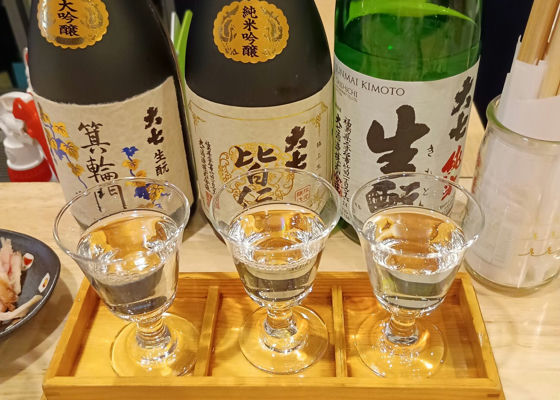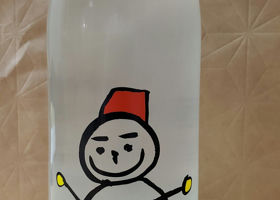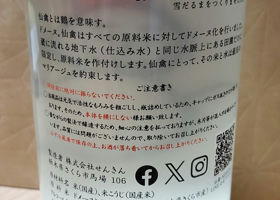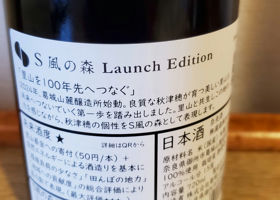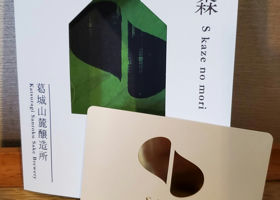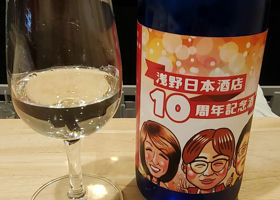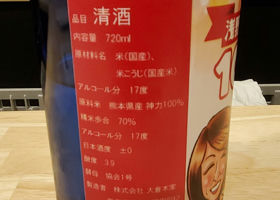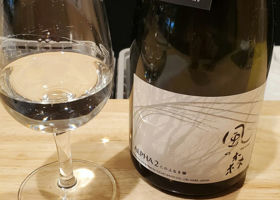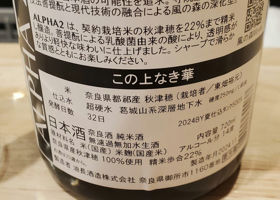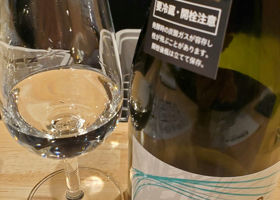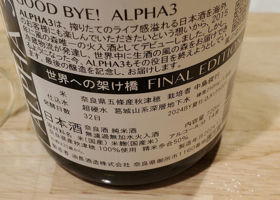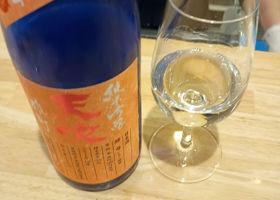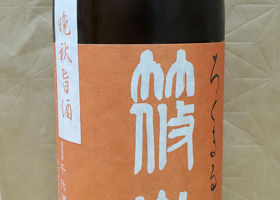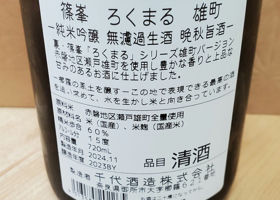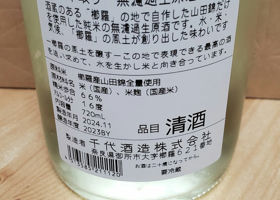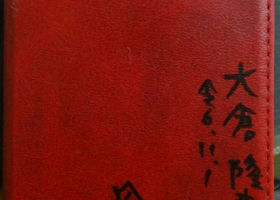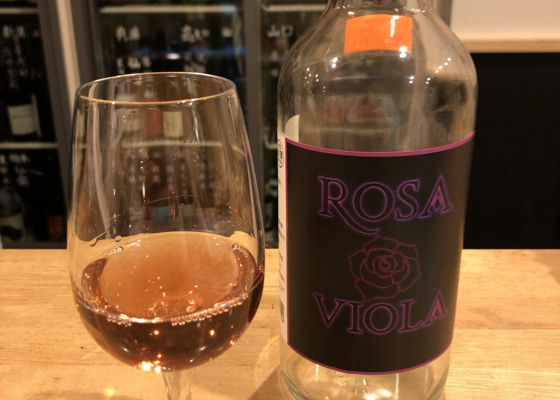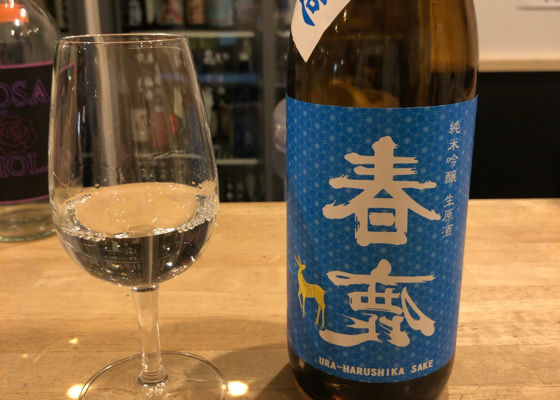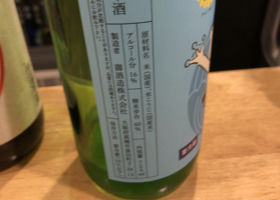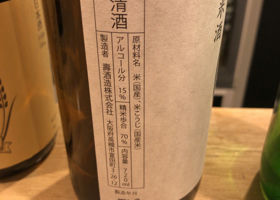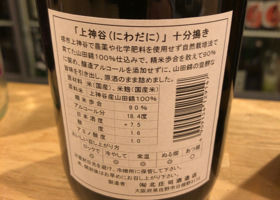Timeline
たっつうThe third cup is Eiheiji Hakuryu from Fukui.
It is a simple sake that is light, mild and easy to drink, but you will never get tired of drinking it. 🙆♂️
It went well with the shime saba (mackerel) that I served with the entrée. たっつうNext is Choryu's Shikisaki.
It is a high level sake with a rich, full-bodied taste, like a dry white wine with a smooth texture 🍶.
Chihshihi-hizoku" seems to be a word that describes the time when the earth begins to freeze. たっつうKaku-uchi at Asano Sake Shop.
First up was the Amabuki, which I had been curious about for a while.
It is not as strawberry-like as I expected, but the sweet and sour taste of strawberries spreads slightly.
It was quite delicious. 🙆♂️ アラジンThis year's (drink), this year's (check in) ✅ 🍶 that 🍶 🍶 (🍶)
Due to the busy schedule towards the end of the year, we've accumulated a lot of alcohol that we haven't been able to check in 📷.
Check-in cleaning 🧹.
Sentori has undergone a brand renewal of "Edobari" this season and all the sake is now made with a new raw sake yeast.
I had been curious about it and had a chance to try it!
Since time was short and I could only have one sake, I selected Nakadori from the Hatsu Tank series for now.
Due to the convenience of the restaurant, the opened bottle was not enough for the prescribed amount, so we had to have some from the open bottle.
The restaurant suggested that we share a glass, and we ended up having a maniacal drinking comparison between the bottom of the bottle and the opening of the bottle of SENKORY Hatsubatake Nao Kumi Nakadori!
The glass on the left is the bottom of the bottle and the one on the right is the open mouth.
The left glass on the left is the bottle bottom, and the right is the open mouth. The ogara-gara-mi was beautiful, but the tailings were a little thicker in the bottle bottom.
The taste was softer and softer than I expected, and the flavor was clear and reserved.
I had imagined a sweeter, more pronounced flavor, so this was a bit surprising.
Maybe because it is a medium-bottled sake, the taste is less cloying and more refreshing 🤔.
The flavor profile was a little clearer than the bottom of the bottle! アラジンThis year's (drink), this year's (check in ✅) 🍶 that ⑨.
It's the end of the year and I've accumulated a lot of alcohol that I haven't been able to check in 📷Check-in cleanup 🧹.
Only 3 hours left in the year😇
Kaku-uchi at Asano Sake Shop Umeda.
I asked for Echigo Tsurukame's new brand, Echigo-Itsuru, which I've been curious about for a long time.
The pure white label with the subtitle "s-trooper" reminded me of a stormtrooper from Star Wars.
The brewer is probably a Star Wars fan, as there are other Koshuya brands such as "M-Falcon" and "death⭐︎star" 😁.
We had a mouthful of the last bottle in the store 🍶.
It has a strong schwashy feel!
The appearance is a clear, strong mist white.
The aroma is fresh and gorgeous pear and melon.
Slight pickle feeling lurks in the back of it.
The mouth is stimulated by a pleasant gaseous sensation.
The spreading sweetness is moderate, but the fresh acidity gives it a modern taste.
The slight pickle sensation lurks in the middle and after, but it is not bothersome, and the wine is refreshingly modern and pleasant to drink.
Modern!
But it is not overdone, and the natural feeling is just right and delicious!
I will try to follow Koshitai a little more! ワカ太Good evening, Aladdin 😃I've never heard of Koshien, but Aladdin's post made me really interested in it ‼️ I don't know where Osaka is though 😅.
Next year I will try to follow Aladdin's sake even more than this year ‼️ ひるぺこGood evening, Aladdin. Good luck with your raging catch-up review and the rest of 2024 💪Good New Year's 👋 アラジンGood evening, Wakata!
Echigo-Tsurukame has a different brand name, Echigo-Tsurukai!
It has the same plain white label as Ebi White, but you can't see it, but it has the Echigo Izo mark that looks like a cloud of muscular clouds: ☁️
At least Asano Sake Shop carries it 🍶. アラジンGood evening, Hirupeco 😃.
Only 2 more drinks left in the year! I'm in the middle of a rave!
I have an hour and a half left so I should be able to make it ⏳😇
Thank you for your help this year!
Have a drunken New Year 🍶. コタローHappy New Year, Aladdin 🎍✨ and I look forward to working with you again this year 😌.
I am also a s-trooper 😆 I am even more excited to read your review 🥳I had a m-falcon the other day and it was delicious👍. アラジンHappy New Year, Kotaro 🌅Please have a great new year 🎍.
I envy you being able to drink at home ☺️M- I wish I could have had a Falcon 🤤.
Looking forward to checking in with you Kotaro 🍶😊. Nf bapakVisited at the Daishichi Fair.
There are three kinds of sake: Junmai-Nikaho, Kaiden (Junmai-Ginjo), and Minowamon (Junmai-Daiginjo).
Starting with the Junmai Namahashio classic neat umakuchi, the classic feeling fades and becomes more refined as the grade goes up from Kaiden to Minowamon.
However, the price goes up so much that it is difficult to afford Minowamon, so I decided not to miss this opportunity and went there.
On the other hand, it might be a good idea to go for a big bottle of Minowamon once a year.
There are still many sake that I would like to try, so I can't quite get my hands on Minowamon.... boukenALPHA3 is Kaze no Mori's only fire-aged sake
ALPHA3, which was originally intended for the overseas market, will now be discontinued due to improvements in refrigerated distribution technology.
It is fresh and almost like a draft sake, but unlike the usual Kaze no Mori, it has almost no gassiness. It is one of the sweetest Kaze no Mori, with a slight bitterness in the second half.
It has an atmosphere like apple juice with a little bitterness.
I personally prefer it to the regular Kaze no Mori 🤔. ぺっかーるThis is my first snowman.
I was looking forward to it!
It fills the mouth.
It is smooth and cohesive, but is that a collection of fine acidity? That is my impression.
The sweetness is gradually felt. It tasted fresh!
I can see why it is so popular. It's amazing!
I enjoyed this one too!
It's the 3rd day. This one is also amazing!
It seemed to get more and more delicious with each passing day!
Yay for Sentori! ジェイ&ノビィHi Pekkar 😃.
Congratulations on your first snowball 🎉 ⛄️㊗️
It's a delicious treat that won't betray your enjoyment 🤗. ぺっかーるThanks for your comments, Jay & Nobby!
The nigori sake is delicious too!
I would like to try the UA one next time! 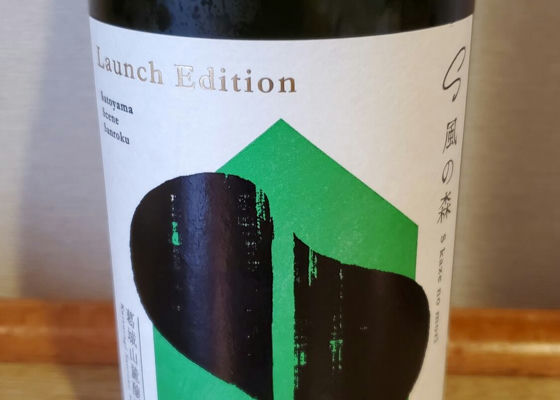
ぺっかーるI looked at the information about the store and saw that it had "S Wind Forest in stock"!
I set out immediately.
I entered the store just as it opened.
There it is!
They were all lined up on the display shelves.
Some bottles had already been reserved. It's amazing!
When I saw the price, I thought, "Hmm? I flinched for about 3 minutes....
It is a little expensive.
But I wanted to drink it anyway.
I took the plunge and picked it up.
I try to drink Kaze no Mori at home as much as possible.
After all, I feel the gasiness is different.
I'll have it from noon!
Wow, I'm so happy!
The aroma is just a little bit of bondoshu.
Does this mean it is isoamyl acetate?
I think it is at a level where you can smell it if you sniff it with all your might.
I felt that the schwashiness was weaker than the usual Kaze no Mori.
Still, you can see a slight effervescence in the glass.
It goes smoothly in the mouth.
It has a banana or grape-like fruitiness.
The acidity and sweetness are just right. Delicious!
I received an envelope with my purchase.
Inside was a "S Kaze no Mori Card" with a serial number!
It has a serial number.
It is a proof of being an ambassador.
I will treasure it. Yay! ぺっかーるWhat a fun label!
The store owner is said to be the model.
The sake level is 0, but it is very sweet.
I didn't think so when I put it in my mouth.
After finishing it, I felt a sweetness like maple syrup.
However, it is not too sweet.
It is very delicious. It was as expected from Mr. Okura!
Congratulations to Asano Sake Brewery on their 10th anniversary. ポンちゃんHello, Pekkar-san 🐦.
Mr. Asano, I see that you can make labels like this in Okura! Is the one with glasses Mr. Asano? I have seen him in Kyoto 😊. ぺっかーるHello, Pon!
I was looking at the bottles on display and found this label in a row! And it's Okura-san!
The one in the middle is the manager and the one on the right is the president! ぺっかーるIt is a Wind Forest with a milling ratio of 22%.
It doesn't have a unique and complex flavor.
However, I felt a strong sense of Kaze no Mori.
The aroma is gorgeous. It is smart and clean.
The refreshing acidity is also nice. ぺっかーるI was influenced by your post.
I want to drink ALPHA3!"
That's how I feel now.
It is ALPHA3 that is being discontinued.
I have been fidgeting since yesterday....
I went to Asano Sake Shop UMEDA for the second time!
I quickly placed my order at the counter.
It is a fire-aged Kaze no Mori. It is not a draft sake.
I would not have recognized it if I had not been told that it was Kaze no Mori, although it was supposed to be delicious....
The taste was different from my impression so far.
Both the aroma and the acidity seem mild.
Still, it is fresh and fruity.
It is delicious in London.
I am glad to have had the Final Edition! Nf bapakClean, clear and slightly fruity.
Asano Sake Brewery Umeda was very crowded on the day of the 10th anniversary because it had just been remodeled.
It may have been due to the fact that it was the last day of the brewery's festival at the Umeda Hankyu (^_^; ).
We had an ALPHA set and an amabuki at the main Kaze no Mori fair, and quickly left. ぺっかーるIt is insanely delicious!
It brings back memories of Shinomine and thinking, "Delicious! The good aroma of the fruit.
The aroma is fruity.
When you put it in your mouth, a moderate acidity spreads.
And the elegant sweetness. I can't get enough of it.
I bought Camembert cheese cod at a convenience store. This went perfectly with it. ジェイ&ノビィGood evening, Mr. Pekkaal 😃.
I wanted to drink Shinomine rokumaru but there was no rokumaru 🥲 so I bought Shige Masu by mistake 😆 I haven't found rokumaru yet 😩 I want to try it 😋. ぺっかーるGood morning, Jay & Nobby!
I saw your past post.
That's what you meant by "so called" lol.
Actually, I once took a bottle thinking it was raifuku and it turned out to be rairaku. Sake is fun~! 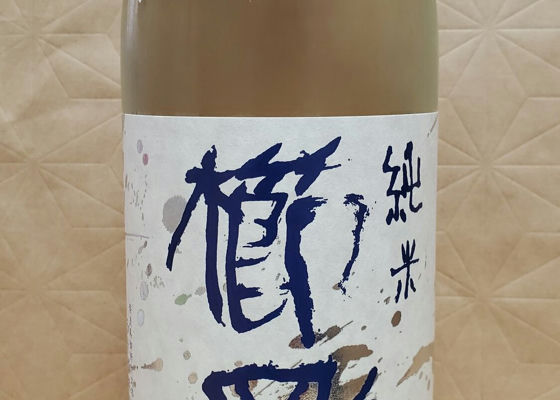
ぺっかーるWe received another autograph!
This time it is Tetsuya Sakai of the Chiyo Sake Brewery.
This is my favorite Shinomine. I was watching the video all over the place (lol).
I can meet him in person!
I went to Asano Sake Shop in Umeda~!
The store was bustling from noon.
I found Mr. Sakai at the counter! He was talking with a customer.
He went to the cash register with two bottles of Kushira and Shinomine. I asked him to speak to me at that moment.
Mr. Sakai, can you sign my book?
He gladly wrote it for me!
I am so happy! I'm going to brag about it at work!
Thank you, Mr. Sakai!
And the next day, Sunday. We started with the Kushira.
It has a fruity aroma. When I put it in my mouth, I could feel a slight shwashiness. The first sip was sweet, but the next sip was refreshingly dry.
I think I will drink it until it runs out....
It was a very delicious sake! ポンちゃんHello, Pekkaal 🐦.
Signature! Nice ✨I hope you like Nara sake, both Kaze no Mori and Okura are awesome 😳I'm sure the sake tastes even better when I meet you in person 😊👍. ぺっかーるGood evening, Pon-chan!
I'm a Hiroshima Carp fan who loves my hometown, Nara, Hyogo. It's complicated, isn't it?
I started my sake swamp with "Kaze no Mori, Umenoyado, and Mimuro Sugi". From there, I've always been a Nara fan, and Nara is the only place I can win! koge2Rice Berry is used. Rice Berry" is a new Thai rice variety created by crossing "Khao Hong Mali (jasmine rice)" and "Khao Hong Nin (purple glutinous rice)" at the Rice Science Center of Kasetsart University.
Is it a metamorphic liquor? I hope it's a metamorphic sake (don't call rice metamorphic).
Berry aroma with a hint of smoke.
The taste is also quite complex. It's a bit of a kick. The taste is also very complex. Berry on the back palate. koge2Shuwa shuwa shuwa . The sweet and sour taste is irresistible. The richness that spreads on the tongue is delicious. koge2I was under the impression that Kuninonaga's attack had no taste. I was under the impression that Kuninochou has no attack flavor. The taste that comes up later is amazing, a subtle acidity in a full-bodied taste.
1800 Chekin backslash\\\\\\\٩٩³( 'omega')و ////// koge2The top aroma is wakame. The first attack was "Too thin, no taste! but as you continue to drink, the flavor comes and goes, and the umami comes and goes. koge2100% Yamadanishiki produced in Kamikamiya, Sakai City.
How can a sake with a 90% rice polishing ratio have a cemedine aroma? It's like candy, but not sweet. RecommendedContentsSectionView.title











